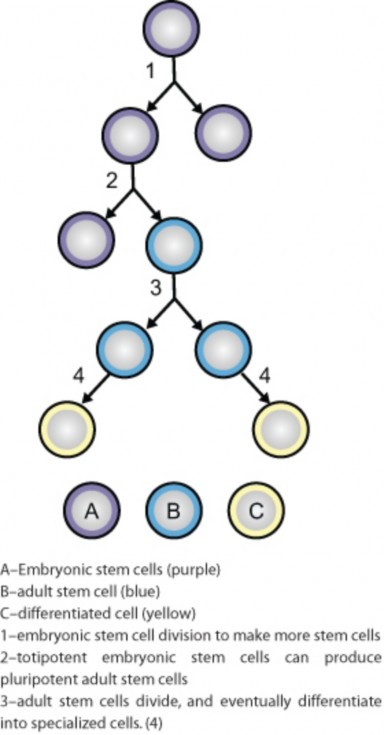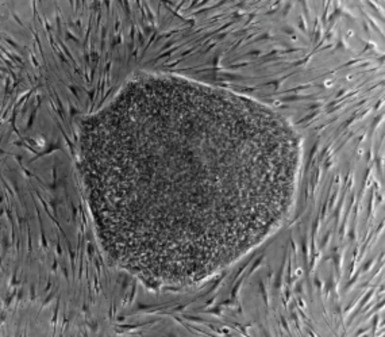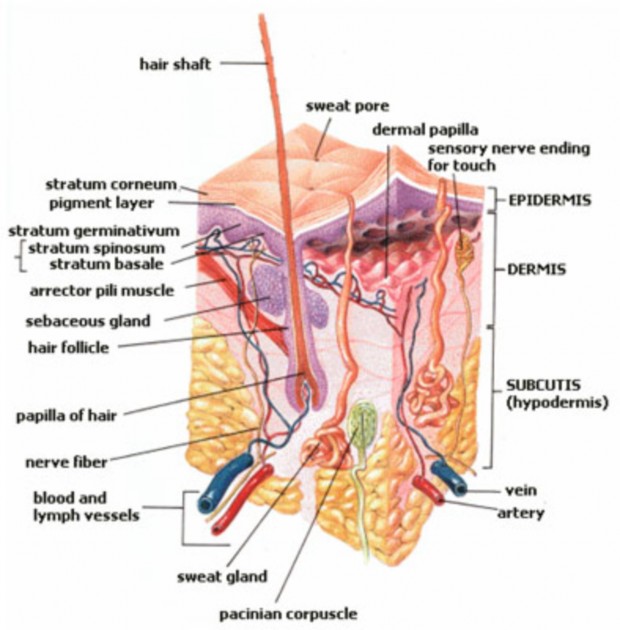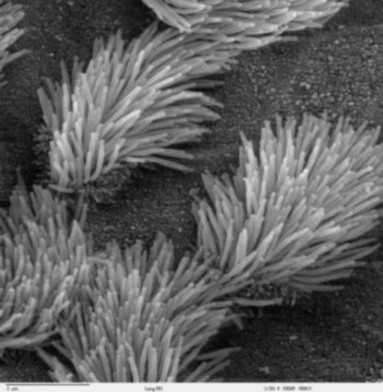Lesson 19.1: Organization of the Human Body
Lesson 19.1: Organization of the Human Body
Lesson Objectives
Describe the levels of organization of the human body.
Outline the role of a specialized cell.
Identify the properties that make body cells and stem cells different from each other.
List three types of stem cells.
Identify the four tissue types found in the human body.
Summarize how tissues and organs relate to each other.
Name two body systems that work together for a common purpose.
Introduction
In most multicellular organisms, not all cells are alike. For example, the cells that make up your skin are different from cells that make up your liver, your blood, or your eyes. Yet, all these specialized cells develop from one single fertilized egg which means all of your cells have the same DNA. But liver, blood, and eye cells are very different from each other in form and function. While these cells are specialized for a specific job, there are other cells in the body that remain unspecialized. These cells multiply continuously to replace the millions of different body cells that die and need to be replaced every day.
Cells
Cells are the most basic units of life in your body. Each specialized cell has a specific function in the body. For example, nerve cells transmit electrical messages around the body, and white blood cells patrol the body and attack invading bacteria. Other cells include specialized cells in the kidney (such as kidney glomerulus parietal cell), brain cells (such as astrocytes), stomach cells (such as parietal cells), and muscle cells (such as red and white skeletal muscle fibers). Cells group together in tissues to carry out a specific function, and different tissues work together to form organs. This grouping of cells and tissues is referred to as levels of organization. Complex multicellular organisms, which include flatworms and humans, have different levels of organization.
Differentiation
Every cell in the body originated from a single fertilized egg, which is called a zygote. The zygote divides many times to produce an embryo. These embryonic cells differentiate into many different cell types which in time give rise to all the cells types present in the body of all humans (and other mammals), from a new-born baby to an elderly adult. Differentiation is the process by which an unspecialized cell (such as a fertilized egg cell), divides many times to produce specialized cells that work together and make up the body. During differentiation, certain genes are turned on, or become activated, while other genes are switched off, or inactivated. This process is regulated by the cell. A differentiated cell will develop specific structures and perform certain functions.
A cell that is able to differentiate into all cell types within a body is called totipotent. They have “total potential” to differentiate into any cell type. In mammals, only the zygote and early embryonic cells are totipotent. A cell that is able to differentiate into many cell types, but not all, is called pluripotent. Such cells have “plural potential,” (but not “total potential”) to differentiate into most but not all cell types.
Stem Cells
An unspecialized cell that can divide many times and give rise to different, specialized cells is called a stem cell, as shown in Figure 19.1. Zygotes and embryonic cells are both types of stem cells. The stem cells found in embryos can divide indefinitely, can specialize into any cell type and are called embryonic stem cells. Embryonic stem cells are totipotent. Undifferentiated cells that are found within the body and that divide to replace dying cells and damaged tissues are called adult stem cells. Adult stem cells can divide indefinitely, and generate all the cell types of the organ from which they originate. They can potentially re-grow the entire organ from just a few cells. A third type of stem cell is found in blood from the umbilical cord of a new-born baby, and the placenta. These ”cord blood stem cells” are considered to be adult stem cells because they cannot generate all body cell types, just different types of blood cells. Therefore, adult stem cells and cord blood stem cells are pluripotent.

Figure 19.1: Division and differentiation of stem cells into specialized cells. (5)
Stem Cells in Medicine
Stem cells are of great interest to researchers because of their ability to divide indefinitely, and to differentiate into many cell types. Stem cells have many existing or potential therapeutic applications. Such therapies include treatments for cancer, blood disorders, brain or spinal cord injuries, and blindness.

Figure 19.2: Human embryonic stem cell colony, which was grown in a laboratory on a feeder layer of mouse cells. Embryonic stem cells are totipotent. A video of human embryonic stem cell and their uses is available at http://www.sumanasinc.com/webcontent/animations/ content/stemcells_scnt.html. An animation of stem cell procedures is available at http:
//www.pbs.org/newshour/health/stem_cells.swf. (3)
Embryonic stem cells, as shown in Figure 19.2, are taken from eggs that were fertilized in the laboratory and donated to research. They may have the greatest potential because they are totipotent, and thus have the most potential medical applications. However, embryonic stem cells harvested from a donated embryo differ from a potential patient’s tissue type. Therefore, just as in organ transplantation, there is a risk of a patient’s body rejecting transplanted embryonic stem cells. Some individuals and groups have objections to the harvesting of embryonic stem cells, because harvesting the stem cells involves the destruction of the embryo. Some researchers are looking into methods to extract embryonic stem cells without destroying the actual embryo. Other researchers have claimed success in harvesting embryonic stem cells from the embryonic fluid that surrounds a growing fetus.
Adult stem cells, including cord blood stem cells, have already been used to treat diseases of the blood such as sickle-cell anemia and certain types of cancer. Unlike embryonic stem cells, the use of adult stem cells in research and therapy is not controversial because the production of adult stem cells does not require the destruction of an embryo. Adult stem cells can be isolated from a tissue sample, such as bone marrow, from a person. Scientists have recently discovered more sources of adult stem cells in the body. Adult stem cells have been found in body fat, the inside lining of the nose, and in the brain. Some researchers are investigating ways to revert adult stem cells back to a totipotent stage.
Tissues
A tissue is a group of connected cells that have a similar function within an organism. The simplest living multicellular organisms, sponges, are made of many specialized types of cells that work together for a common goal. Such cell types include digestive cells, tubular pore cells, and epidermal cells. Though the different cell types create a large organized, multicellular structure—the visible sponge—they are not organized into true tissues. If a sponge is broken up by passing it through a sieve, the sponge will reform on the other side.
More complex organisms such as jellyfish, coral, and sea anemones have a tissue level of organization. For example, jellyfish have tissues that have separate protective, digestive, and sensory functions. There are four basic types of tissue in the body of all animals, including the human body. These make up all the organs, structures and other contents of the body. Figure 19.3 shows an example of each tissue type.
The four basic types of tissue are:
Epithelial tissue is made up of layers of tightly packed cells that line the surfaces of the body for protection, secretion, and absorption. Examples of epithelial tissue include the skin, the lining of the mouth and nose, and the lining of the digestive system.
Muscle tissue is made up of cells contain contractile filaments that move past each other and change the size of the cell. There are three types of muscle tissue: smooth muscle which is found in the inner linings of organs; skeletal muscle, which is attached to bone and moves the body; and cardiac muscle which is found only in the heart.
Nervous tissue is made up of the nerve cells (neurons) that together form the nervous system, including the brain and spinal cord.
Connective tissue is made up of many different types of cells that are all involved in structure and support of the body. Bone, blood, fat, and cartilage are all connective tissues. Connective tissue can be densely packed together, as bone cells are, or loosely packed, as adipose tissue (fat cells) are.

Organs and Organ Systems
Organs are the next level of organization in the body. An organ is a structure made of two or more tissues that work together for a common purpose. Skin, the largest organ in the body, is shown in Figure 21.41. Organs can be as primitive as the brain of a flatworm (a group of nerve cells), as large as the stem of a sequoia (up to 90 meters in height (300 feet)), or as complex as a human liver. The human body has many different organs, such as the heart, the kidneys, the pancreas, and the skin. Two or all of the tissue types can be found in an organ. Organs inside the body are called internal organs. The internal organs collectively are often called viscera.
The most complex organisms have organ systems. An organ system is a group of organs that act together to carry out complex interrelated functions, with each organ focusing on a part of the task. An example of an organ system is the human digestive system in which the mouth and esophagus ingests food, the stomach crushes and liquefies it, the pancreas and gall bladder make and release digestive enzymes, and the intestines absorb nutrients into the blood. An organ can be part of more than one organ system. For example the ovaries produce hormones which make them a part of the endocrine system. The ovaries also make eggs which makes them part of the reproductive system. One of the most important functions of organ systems is to provide cells with oxygen and nutrients and removes toxic waste products such as carbon dioxide. A number of organ systems, including the cardiovascular and respiratory systems, work together to do this.
The different organ systems of the body are shown in Table 19.1. Sometimes the cardiovas- cular system and the lymphatic system are grouped together into one single system called the circulatory system.

Table 19.1: Major Organ Systems of the Human Body
![]()
Organ System Function Organs, Tissues, and Struc- tures Involved
![]()
Cardiovascular Transporting oxygen, nutri- ents and other substances to the body cells, and wastes, carbon dioxide, and other substances away from cells; it can also help stabilize body temperature and pH
Lymphatic Defense against infection and disease, transfer of lymph between tissues and the blood stream
Digestive Processing of foods and ab- sorption of nutrients, miner- als, vitamins, and water
Endocrine Communication within the body with hormones; di- recting long-term change over other organ systems to maintain homeostasis
Integumentary Protection from injury and fluid loss; physical defense against infection by microor- ganisms; temperature con- trol
Muscular Movement, support, heat production
Nervous Collecting, transferring and processing information; di- recting short-term change over other organ systems in order to maintain homeosta- sis
Reproductive Production of gametes (sex cells) and sex hormones; production of offspring
Heart, blood, blood vessels
Lymph, lymph nodes, lymph vessels
Salivary glands, esophagus, stomach, liver, gallbladder, pancreas, small intestine, large intestine
Among many, the pituitary gland, pineal gland, thyroid, parathyroid gland, adrenal glands, testes, and ovaries
Skin, hair, and nails
Skeletal, cardiac, and smooth muscles, tendons Brain, spinal cord, nerves, and sense organs (eyes, ears, tongue, skin, nose)
Fallopian tubes, uterus, vagina, ovaries, mammary glands, testes, vas deferens, seminal vesicles, prostate, and penis
Table 19.1: (continued)
Organ System Function Organs, Tissues, and Struc- tures Involved
Respiratory Delivery of air to sites where gas exchange can occur be- tween the blood and cells (around body) or blood and air (lungs)
Skeletal Support and protection of soft tissues of body; move- ment at joints; production of blood cells; mineral storage
Urinary Removal of excess water, salts, and waste products from blood and body; con- trol of pH
Immune Defending against microbial pathogens (disease-causing agents) and other diseases
Mouth, nose, pharynx, lar- ynx, trachea, bronchi, lungs, and diaphragm
Bones, cartilage, ligaments
Kidneys, ureters, urinary bladder, and urethra
Leukocytes, tonsils, ade- noids, thymus, and spleen
![]()
Lesson Summary
Not all cells are alike in a multicellular organism, but all of the cells in a multicellular organism have the same DNA.
Each specialized cell has a specific function in the body. Specialized cells group together to carry out a specific function.
Every cell in the body originated from a single zygote. The unspecialized zygote differentiates to produce specialized cells that work together and make up the body.
A cell that is able to differentiate into all cell types within a body is totipotent. Em- bryonic stem cells are totipotent.
A cell that is able to differentiate into many cell types, but not all types, is pluripotent. Adult stem cells and cord blood stem cells are pluripotent.
A tissue is a group of connected cells that have a similar function within an organism. There are four basic types of tissue in the body of all animals: connective, muscle, nervous, and epithelial.
An organ is a structure made of two or more different types of tissue that work together for a common purpose.
An organ system is a group of organs that act together to carry out complex related functions, with each organ focusing on a part of the task.
Review Questions
Further Reading / Supplemental Links
Give three examples of specialized cells.
Contrast specialized cells and stem cells.
Name three sources of stem cells.
List the four tissue types that are found in the human body, and give an example of each type.
These cells form the lining of the trachea. Identify the cells and the type of tissue of which the ciliated cells in Figure 19.5 are a part.

Summarize the relationship between tissues and organs.
Identify an organ that is part of two body systems.
A classmate says that the lymphatic system should not be an organ system in its own right, and is a part of the cardiovascular system. Do you agree or disagree with your classmate? Explain your answer by using your knowledge of organ systems.
Human Anatomy ©2003 by Fredric H. Martini, Inc. and Michael J.Timmons. Pub- lished by Pearson Education, Inc.
http://web.jjay.cuny.edu/~acarpi/NSC/14-anatomy.htm
Vocabulary
adult stem cells Undifferentiated cells that are found within the body and that divide to replace dying cells and damaged tissues.
cell The most basic unit of life; basic unit of structure and function in living organisms.
differentiation The process by which an unspecialized cell (such as a fertilized egg cell), divides many times to produce specialized cells that work together and make up the body.
embryonic stem cells Stem cells found in embryos that can divide indefinitely, and spe- cialize into any cell type.
organ A structure made of two or more tissues that work together for a common purpose.
organ system A group of organs that act together to carry out complex interrelated func- tions, with each organ focusing on a part of the task.
pluripotent A term that describes a cell that is able to differentiate into many cell types, but not all, within a body.
stem cell An unspecialized cell that can divide many times and give rise to different, specialized cells is called a stem cell.
tissue A group of connected cells that have a similar function within an organism.
totipotent A term that describes a cell that is able to differentiate into all cell types within a body.
Points to Consider
The smallest unit capable of carrying out life processes in your body is a single cell. Cells organize into tissues, which organize into organs. Groups of organs work together as organ systems. Consider how the last meal you consumed is interacting with each level of organization in your body.
Think about the advantages and disadvantages of having a body composed of many small cells as opposed to a single large cell.
- Log in or register to post comments
- Email this page
